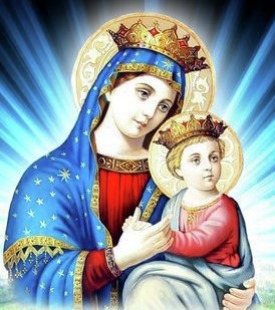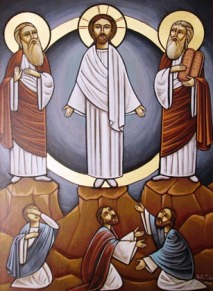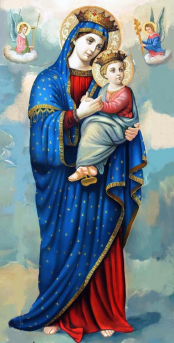
"Awake, O My Harp, Your Chords,
In Praise of the Virgin Mary!
Lift Up Your Voice and Sing
The Wonderful History of this Virgin,
The Daughter of David,
Who Gave Birth to the Life of the World!"
-- St. Ephram the Syrian
As Biblical history has recorded, St. Mary is the central figure in the two Gospel accounts of the birth of the Lord Jesus Christ. The "Mother of God" is seldom mentioned in the New Testament outside of the birth narratives in the opening chapters of St. Matthew and St. Luke. The name of St. Mary is mentioned only once in the Holy Gospel of St. Mark and the Holy Book of Acts. The Blessed Virgin is never explicitly named in the New Testament Letters. The name of St. Mary is only "referred to" in two episodes written by St. John in his Holy Gospel.

During the month of August, the Coptic Church celebrates the Feast of the Transfiguration of our Lord Jesus Christ on Mount Tabor. The Feast of the Transfiguration is considered one of the seven Minor Feasts of the Lord. The Transfiguration is mentioned in Matthew 17:1-13, Mark 9:2-13, and Luke 9:28-36.
It is stated in both St. Matthew's and St. Mark's Holy Gospels those six days after the Lord's conversation with His disciples regarding the Cross-, He took St. Peter, St. James and St. John on a high mountain and was transfigured before them. St. Luke alludes to the same story but the length after the Lord's conversation was eight days. Is there a contraindication in Holy Scripture? No, it is thought that St. Luke counted the day of His conversation about the Cross-and the day of the Transfiguration; and that St. Matthew and St. Mark did not count those two days. This explains why St. Luke used the phrase, "about eight days after," while St. Matthew and St. Mark mentioned that it "was after six days."

LIFE OF HUMILITY
Humility was a fundamental condition for her of whom the Lord of Glory will be born. It was indispensable that He would be born from a humble person, who could bear the glory of the divine Incarnation from her, the glory of the coming of the Holy Spirit in her, and the glory of the nativity of the Lord from her, and the glory of all the generations blessing her, and the humility of Elizabeth in front of her saying to her: "But why is this granted to me, that the mother of my Lord should come to me?" (Luke 1:43). Likewise to bear the glory of all the apparitions of angels, and the worship of the Magi in front of her Son, and the many miracles which happened by her son in the land of Egypt, and the light of this Son in her bosom. That is why, "the fullness of the time" (Gal. 4:4) waited for this human being from whom the Son of God was born.
This humility was manifested in her life, as we shall see: The angel announced to her that she will become the mother of the Lord, but she said: "Behold the maid-servant of the Lord" (Luke 1:38), that is his slave and his maiden. The magnificent glory which was given to her, absolutely did not decrease by her humility. But rather it was because of this humility that the Lord granted her that glory. "For He has regarded the lowly state of His maidservant" and made great things for her (Luke 1: 48, 49).
The humility of the Virgin was also manifested in her going to Elizabeth in order to serve her, during the period of her pregnancy. As soon as she heard that she was pregnant, in her sixth month, she traveled to her in a tiring journey across the mountains. She remained with her for three months, till her days were complete to give birth (Luke 1: 39-56). She did so while she was pregnant with the Lord of glory. Her lack of talking about the glories of the divine Incarnation, is a sign of her humility.



 RSS Feed
RSS Feed